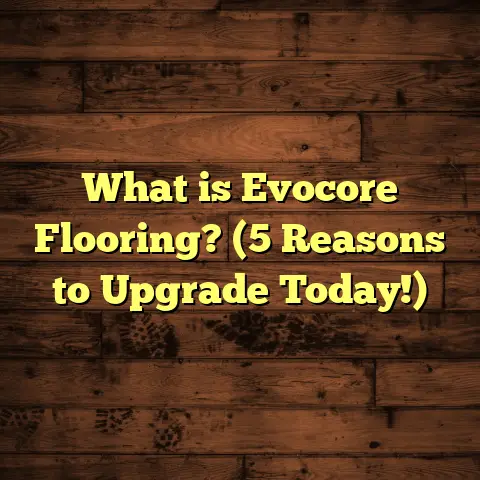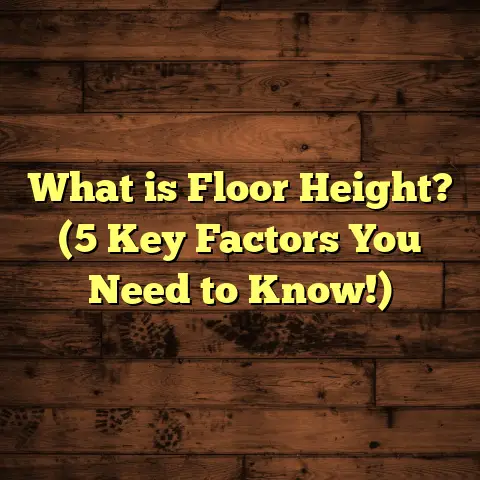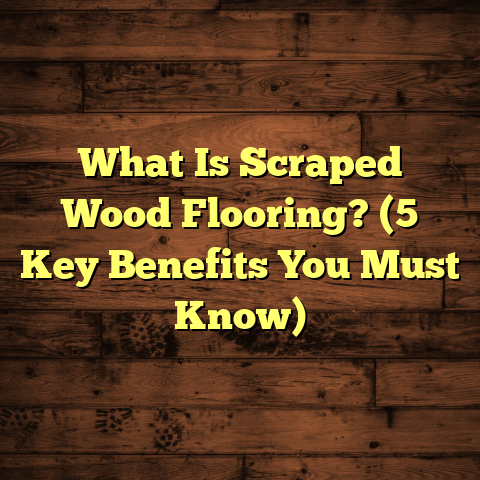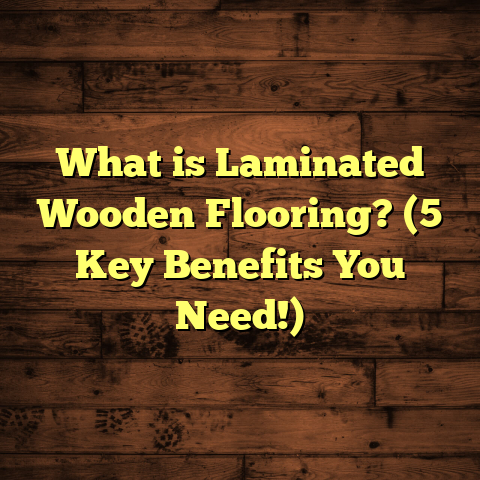What is LVT Wood Flooring? (5 Benefits You Didn’t Know!)
Did you know that luxury vinyl tile (LVT) flooring has surged in popularity, with a staggering 20% increase in demand over the past five years? It’s become a go-to choice for homeowners and designers alike, and for good reason! Personally, I’ve had the pleasure of working with LVT in various projects, and I can confidently share that it’s not just a passing trend. So, let’s explore what makes LVT wood flooring a fantastic option, along with five benefits that might surprise you.
Aesthetic Appeal
One of the first things that hit you when you step onto LVT wood flooring is its stunning visual appeal. At first glance, it can be hard to distinguish from real hardwood. The technology behind LVT has advanced so much that manufacturers can replicate the intricate details of wood grain, knots, and even color variations. I remember the first time I installed LVT in a client’s home; they were amazed at how authentic it looked.
Imagine walking into your living room, and the warm tones of the flooring greet you like a sunny day. It’s inviting and cozy, making it perfect for family gatherings or quiet evenings at home. Plus, with a variety of styles available, you can choose something that perfectly matches your décor—whether that’s rustic farmhouse or sleek modern.
Personal Touch
I think what I love most about LVT is its versatility. You can find it in almost any style or finish you desire. During one project, I helped a couple select LVT that mimicked reclaimed barn wood. They were thrilled because it gave their home a rustic charm without the high maintenance that comes with real wood.
This ability to personalize your space is key. Whether you’re going for a contemporary vibe or something more traditional, LVT can adapt to your vision. It truly allows homeowners to express their style without limitations.
Durability That Lasts
Now, let’s talk about durability. I’ve seen my fair share of flooring materials scratch or wear down over time, especially in high-traffic areas. But LVT stands strong against the daily grind. It’s designed to withstand scratches, stains, and dents better than traditional hardwood flooring.
In fact, most LVT products come with a wear layer that protects the surface from everyday wear and tear. I remember a family who had three energetic kids and two dogs—after several years of using LVT, the floor still looked as good as new. This kind of resilience means you won’t need to worry about replacing your floors anytime soon, saving you time and money in the long run.
Real-Life Examples
Consider a situation where homeowners are looking to install flooring in a busy entryway. Traditional hardwood could easily get scratched and show wear after just a few months. With LVT, I’ve seen clients enjoy their floors for years without any visible signs of damage—even with heavy foot traffic! This durability factor is crucial for families or anyone who values both aesthetics and practicality.
Water Resistance
If you’ve ever dealt with water damage on hardwood floors, you know how costly and frustrating it can be. This is where LVT really shines. Most luxury vinyl tiles are water-resistant or even waterproof, making them an excellent choice for kitchens, bathrooms, and basements.
A couple of years ago, I had a client who was hesitant to put hardwood in their kitchen due to potential spills and messes. We opted for LVT instead, and they were thrilled! They could clean up without fear of ruining their beautiful floors. And let’s face it; if you’ve got kids or pets, spills are bound to happen!
Testing Water Resistance
I often conduct informal tests with my clients to show them how well LVT holds up against water. We pour some water on the sample and wipe it off after a few minutes. The relief on their faces when they see no damage is priceless! This feature makes LVT a reliable choice for any area prone to moisture.
Easy Installation
Here’s another perk: installation is a breeze! LVT can often be installed over existing flooring without the need for extensive prep work. Whether it’s glue-down or click-lock styles, I’ve seen both methods work effectively depending on the situation.
I once helped a friend who wanted to revamp her living room over a weekend. We chose a click-lock LVT product that allowed us to lay down the planks quickly and easily. The satisfaction of seeing her space transformed so rapidly was incredible!
Installation Techniques
When it comes to installation techniques, I’ve found that the click-lock method is particularly popular among DIY enthusiasts. It requires no adhesive or nails—just snap the planks together! For those looking for a more permanent solution, glue-down methods provide incredible stability.
I always advise my clients to consider their skill level when deciding on an installation method. If you’re comfortable with tools and measuring, go for the click-lock! If not, hiring a professional might be the way to go.
Maintenance Made Simple
Let’s be honest—who has time for complicated cleaning routines? One of the best things about LVT wood flooring is how low-maintenance it is. A simple sweep and occasional mop are usually all it takes to keep your floors looking fresh.
I often tell my clients that unlike traditional wood floors that might require refinishing after several years, LVT just needs some basic care. I’ve seen homeowners spend countless hours sanding and staining hardwood just to maintain their luster, but with LVT, they can enjoy their time instead of stressing about upkeep.
Cleaning Tips
Regular maintenance is key to keeping your LVT looking its best. Here are some cleaning tips I share with my clients:
- Sweep Regularly: A quick sweep with a soft broom helps remove dirt and debris.
- Mop with Care: Use a damp mop with mild soap specifically designed for vinyl.
- Avoid Harsh Chemicals: They can damage the finish; stick to gentle cleaners.
- Use Furniture Pads: Protect your floors from scratches by placing pads under furniture legs.
- Address Spills Quickly: Wipe up spills immediately to prevent stains.
These simple steps make maintaining LVT floors incredibly easy!
Cost-Effective Solution
Finally, let’s address the elephant in the room: cost! LVT is often more affordable than solid hardwood while providing similar aesthetics and durability. With prices averaging around $2 to $5 per square foot compared to hardwood’s $5 to $10 or more, it’s an attractive option for budget-conscious homeowners.
I recently worked on a project where the homeowner was trying to stick to a budget but didn’t want to compromise on style. After selecting LVT, they were able to achieve the look they wanted without breaking the bank! It’s moments like these that remind me how beneficial choosing LVT can be for many families.
Budgeting Tips
When planning your flooring project, here are some budgeting tips:
- Get Multiple Quotes: Always compare prices from different suppliers.
- Consider Installation Costs: Factor in whether you’ll DIY or hire professionals.
- Look for Sales: Many retailers offer discounts throughout the year.
- Calculate Waste Factor: Always order extra material (around 10%) for cuts and mistakes.
By carefully planning your budget, you can enjoy beautiful floors without overspending!
Design Flexibility
One of the unique aspects of LVT wood flooring is its design flexibility. Since it’s available in various styles and colors, it can fit seamlessly into any design scheme. Whether you’re going for modern minimalism or classic elegance, there’s an LVT option for you.
I once worked on a project where we used light-colored LVT planks in a small apartment to create an illusion of space. The open feel made the home appear larger and more inviting—a perfect example of how flooring choice impacts overall design!
Trendy Designs
Here are some trending designs worth considering:
- Herringbone Patterns: Adds visual interest and sophistication.
- Wide Planks: Gives a modern touch while making spaces feel larger.
- Textured Finishes: Mimics the feel of real wood and enhances authenticity.
- Color Variations: From gray tones to rich browns—choose what complements your space best!
Selecting the right design can transform your home’s atmosphere dramatically!
Eco-Friendly Options
For those concerned about environmental impact, many manufacturers now produce eco-friendly LVT options using sustainable materials. These products often come with certifications indicating they meet certain environmental standards.
I’ve had clients express concern about their carbon footprint when renovating their homes. By choosing eco-friendly LVT, they felt better about their flooring decision while still enjoying all its benefits.
Eco-Friendly Practices
Here are some eco-friendly practices regarding flooring:
- Look for Certifications: Seek products with certifications like FloorScore or GreenGuard.
- Check Material Sources: Some brands use recycled materials in their construction.
- Consider End-of-Life Options: Research manufacturers that offer recycling programs.
Choosing eco-friendly options not only benefits your home but also contributes positively to the environment!
Comparing LVT with Other Flooring Types
It’s essential to understand how LVT stacks up against other flooring options like hardwood, laminate, or tile. While each type has its merits, there are distinct advantages that make LVT stand out.
- Hardwood vs. LVT: Hardwood offers timeless beauty but requires more maintenance and can be susceptible to moisture damage.
- Laminate vs. LVT: Laminate is often less expensive but lacks the water resistance and durability of LVT.
- Tile vs. LVT: Tile is durable but cold underfoot; LVT provides warmth while still being highly resilient.
Understanding these differences can help homeowners make informed decisions based on their unique needs.
Case Studies: Real-Life Transformations
To illustrate the transformative power of LVT flooring further, let me share some case studies from my experience:
Case Study 1: The Busy Family Home
A family of five approached me looking for flooring that could withstand their hectic lifestyle—three kids plus two dogs meant messes were inevitable! We installed a wood-look LVT in their main living area and kitchen.
After six months, they reported no scratches despite daily foot traffic and occasional spills. They loved how easy it was to clean up after messy playdates!
Case Study 2: The Small Apartment
Another client lived in a cozy urban apartment with limited space but wanted a fresh look without compromising on style. We opted for light-colored wide plank LVT arranged in a herringbone pattern.
The result was stunning! Not only did it visually expand their living area, but it also added a chic touch that impressed guests.
These case studies highlight how beneficial LVT can be in various situations!
Conclusion: Why Choose LVT Wood Flooring?
So there you have it—LVT wood flooring isn’t just another trend; it offers substantial benefits that can enhance your home life. From its stunning looks and long-lasting durability to ease of maintenance and cost-effectiveness, it’s an option worth considering for your next flooring project.
Have you tried LVT in your home? What was your experience like? I’d love to hear your thoughts! Let’s keep the conversation going about this fantastic flooring option!





